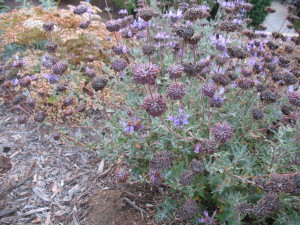Ingredients
-
•3/4 pound unsalted butter, at room temperature
-
•3/4 cup granulated white sugar
-
•1/4 cups packed light brown sugar
-
•1 teaspoon pure vanilla extract
-
•3 1/2 cups all-purpose flour
-
•1/4 teaspoon salt
-
•Five California native salvia leaves, grown organically, washed and dried
-
•Extra granulated sugar for sprinkling on top, if desired
Directions
Pick five to seven sage leaves. All California native sages are edible for culinary purposes. Sage is not commonly considered to be a plant that people are allergic to, but be safe. Ensure you (and other consumers of this treat) are not allergic to any herbal materials before using.
Wash the sage leaves under cool tap water and pat dry. Chop into small mince and hold aside.
Preheat the oven to 300 – 325 degrees. I like to use a cooler temperature and cook for longer – easier to avoid burning the bottom or edges that way.
In the bowl of an electric mixer fitted with a paddle attachment, beat the butter and the two sugars until they are nicely combined. Add the vanilla. Sift together the flour and salt, then add them to the butter-and-sugar mixture. Add chopped sage. Stir in by hand, at first. Once the mixture is lightly combined, mix on low speed until the dough starts to stick to itself in a ball. Scrape out the dough onto your work surface which has been dusted with flour. Shape the dough with your hands into a thick, flat disk. Wrap or store in a container and chill for 30 minutes.
Bring the dough out of the refrigerator and, before it starts to warm up, roll the dough 1/2-inch thick and cut into 3 by 1-inch finger-shaped rectangles. Place the cookies on an un-greased baking sheet and sprinkle with sugar. Bake for 20 to 25 minutes, until the edges begin to brown.
Watch carefully to avoid burning, especially if you use the higher temperature. Pull the sheet from the oven and place on a cooling rack. Allow to come to room temperature.
Serve warm from the oven, room-temperature or chilled, whatever is your preference.
Alternatively, you can press the dough into a round pie tin, score the dough with a knife and then break into pie-shaped wedges once they return to room temperature.
